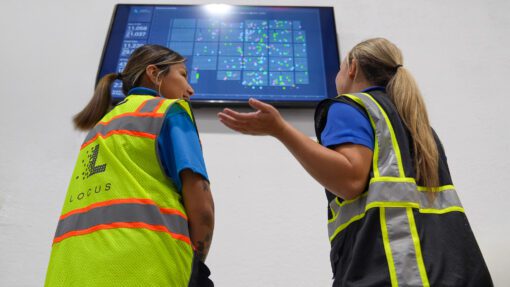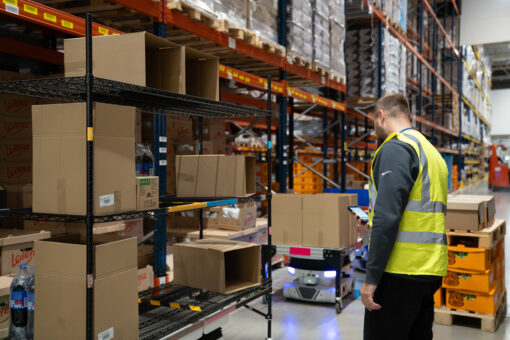WP: How to achieve 400 UPH with Locus Fast Pick
WP: How to achieve 400 UPH with Locus Fast Pick Download Now!
Warehouse Automation Reflections for 2024 and What Lies Ahead in 2025: Part 3/3
Rick Faulk, Chief Executive Officer

Now that I’ve looked back at 2024 and offered my warehouse automation predictions for 2025, let’s turn to the three areas warehouse leaders should concentrate on to prepare their operations for the future.
- Flexibility vs. Density
Modern supply chains must rapidly adapt to shifting demand, escalating SKU counts, new product lines, and evolving customer expectations. Fixed, monolithic systems can increase density but trap businesses in outdated processes.
However, if density is the primary factor in selecting a warehouse automation system, operators should weigh the tradeoffs between fixed and mobile automation. Fixed automation systems, such as ASRS and Goods-to-Person systems, typically offer higher storage density and optimized space utilization, making them ideal for operations with consistent, high-volume workflows.
In preparing for the future, things to consider include:
- Mobile Automation: Adopt technologies like AMRs and RaaS models that can be deployed quickly and scaled up or down with minimal disruption.
- Modular Infrastructure: Design systems and workflows with modular components that can be easily reconfigured or expanded. This allows businesses to quickly adapt to changing operational requirements without significant downtime or investment.
- Process Reconfiguration: Plan for workflows that can be easily rearranged to accommodate peak seasons or unexpected surges.
- Density Requirements: Assess how each automation option meets your warehouse’s density requirements. Compare the space utilization and storage capacities of fixed and mobile systems to ensure the chosen solution can meet the requirements for the next 3-5 years.
- Throughput
Speed remains a critical differentiator in logistics. Customers expect faster delivery, so boosting throughput while maintaining accuracy is essential to staying competitive.
In preparing for the future, things to consider include:
- Workflow Optimization: Streamline each touchpoint in the warehouse to minimize unnecessary movement or downtime. This might consist of zone-picking strategies or automated conveyance between picking stations.
- Scalable Capacity: Use flexible automation to handle peak periods, such as subscribing to additional robots, so you only pay for higher capacity when needed.
- Real-Time Adaptability: Leverage AI and real-time data to dynamically adjust workflows, prioritize tasks, and reallocate resources, ensuring maximum efficiency and throughput even as order volumes and priorities shift.
- Comprehensive Audit: Conduct a thorough audit of your current workflows to pinpoint capacity constraints and operational bottlenecks. Then, develop a multi-year roadmap for boosting throughput through automation, layout reconfiguration, and focused staff training.
- Intelligence
Simple historical data-driven operations will soon become table stakes in modern warehouses. The next wave of intelligence involves advanced analytics, AI, and system-direct actions that learn from real-time conditions and make instant operational tweaks.
In preparing for the future, things to consider include:
- Data-driven decision-making: Leverage advanced analytics and AI to monitor real-time performance metrics, predict demand fluctuations, and optimize resource allocation. Integrate your WMS, ERP, and robotics platforms into a unified ecosystem. Build internal analytics expertise while partnering with cutting-edge providers to turn raw data into actionable insights.
- System Directed Optimization: Implement AI-driven systems such as LocusONE™ that dynamically adjust workflows, task priorities, and resource allocations in real-time, ensuring optimal performance even as conditions and demands shift unpredictably. AI can recognize objects such as MHE, and the system can automatically replan activities.
- Predictive Insights: Use historical trends and AI algorithms to forecast inventory locations, anticipate maintenance issues, and optimize staffing well before bottlenecks occur.
- Workflow Simulation and Scenario Planning: Harness simulation tools to model workflows and evaluate the impact of potential changes before implementation. This capability enables proactive decision-making, reduces operational risks, and ensures seamless adaptation to new strategies or fluctuating demands.
Locus is here to help you be successful with your warehouse operations.
My email is [email protected], and my cell number is 978-886-9999 if you ever want to chat.
About the Author
Rick leads the executive team with over 30 years of experience in executive management, sales, and marketing for some of the world’s most successful technology companies, such as Cisco, Intronis, j2 Global, WebEx, Intranets.com, Barracuda Networks, Lotus Development, Mzinga, and PictureTel. Rick leads the executive team and is responsible for the overall strategy and execution at Locus Robotics. Rick currently sits on various boards and is an advisor to multiple companies, including Retrocausal, Arccos, Cybernetix Ventures, and Leading Edge Ventures. Past board positions include Yodle, Virtual Computer, Bidding for Good, Skill Survey, Influitive, Ntirety, Blue Raven, and Centive.




